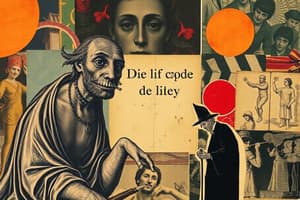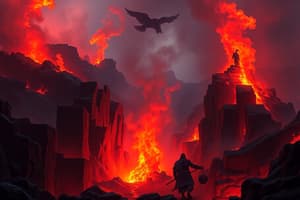Podcast
Questions and Answers
¿Cuál es el nombre del poeta romano que guía a Dante en su viaje por el Infierno?
¿Cuál es el nombre del poeta romano que guía a Dante en su viaje por el Infierno?
- Aristóteles
- Virgilio (correct)
- Estacio
- Homero
¿Cuál es el tema principal explorado en el Purgatorio?
¿Cuál es el tema principal explorado en el Purgatorio?
- La purificación y el crecimiento espiritual (correct)
- La condena y la redención
- El pecado y la moralidad
- La sabiduría divina y la éxtasis
¿Qué representa el personaje de Beatriz en la Divina Comedia?
¿Qué representa el personaje de Beatriz en la Divina Comedia?
- El orgullo y la rebelión contra Dios
- El pecado y la confusión moral
- La razón y la sabiduría humana
- El amor divino y la redención (correct)
¿Cuál es el nombre del río que representa la frontera entre la vida y la muerte?
¿Cuál es el nombre del río que representa la frontera entre la vida y la muerte?
¿Cuál es el nombre de la técnica literaria utilizada por Dante para transmitir significados ocultos y simbolismos?
¿Cuál es el nombre de la técnica literaria utilizada por Dante para transmitir significados ocultos y simbolismos?
Study Notes
The Divine Comedy
Inferno
- The first part of The Divine Comedy, written by Dante Alighieri
- Divided into 34 cantos
- Describes Dante's journey through the nine circles of Hell, guided by the Roman poet Virgil
- Explores themes of sin, morality, and redemption
- Features encounters with famous figures from history and mythology, including Homer, Aristotle, and Alexander the Great
Purgatorio
- The second part of The Divine Comedy
- Divided into 33 cantos
- Describes Dante's journey through Purgatory, guided by Virgil and later by Beatrice
- Explores the themes of purification, penance, and spiritual growth
- Features encounters with souls who are being purified before entering Heaven, including famous figures such as Statius and Manfred
Paradiso
- The third and final part of The Divine Comedy
- Divided into 33 cantos
- Describes Dante's journey through Heaven, guided by Beatrice and later by Saint Bernard
- Explores the themes of divine love, wisdom, and ecstasy
- Features encounters with blessed souls, including saints, angels, and the Virgin Mary
Dante's Use of Allegory
- Allegory is a literary device used to convey hidden meanings and symbolism
- Dante uses allegory throughout The Divine Comedy to convey moral, philosophical, and theological themes
- Examples of allegory include:
- The character of Beatrice, representing divine love and redemption
- The three beasts in the forest, representing sin, worldliness, and moral confusion
- The river Styx, representing the boundary between life and death
Alegoría de los personajes (Allegory of Characters)
- Dante uses allegory to represent abstract concepts and ideas through characters
- Examples of allegorical characters include:
- Virgil, representing reason and human wisdom
- Beatrice, representing divine love and redemption
- Lucifer, representing pride and rebellion against God
- The three beasts, representing sin, worldliness, and moral confusion
- The character of Dante himself, representing the human soul on a journey towards redemption
La Divina Comedia
Infierno
- La primera parte de La Divina Comedia, escrita por Dante Alighieri
- Dividida en 34 cantos
- Describe el viaje de Dante a través de los nueve círculos del Infierno, guiado por el poeta romano Virgilio
- Explora los temas del pecado, la moralidad y la redención
- Presenta encuentros con figuras famosas de la historia y la mitología, como Homero, Aristóteles y Alejandro Magno
Purgatorio
- La segunda parte de La Divina Comedia
- Dividida en 33 cantos
- Describe el viaje de Dante a través del Purgatorio, guiado por Virgilio y luego por Beatrice
- Explora los temas de la purificación, la penitencia y el crecimiento espiritual
- Presenta encuentros con almas que se purifican antes de entrar en el Cielo, incluyendo figuras famosas como Estacio y Manfredo
Paraíso
- La tercera y última parte de La Divina Comedia
- Dividida en 33 cantos
- Describe el viaje de Dante a través del Cielo, guiado por Beatrice y luego por San Bernardo
- Explora los temas del amor divino, la sabiduría y el éxtasis
- Presenta encuentros con almas benditas, incluyendo santos, ángeles y la Virgen María
Uso de la alegoría de Dante
- La alegoría es un dispositivo literario que se utiliza para transmitir significados ocultos y simbolismo
- Dante utiliza la alegoría en toda La Divina Comedia para transmitir temas morales, filosóficos y teológicos
- Ejemplos de alegoría incluyen:
- El personaje de Beatrice, que representa el amor divino y la redención
- Los tres animales en el bosque, que representan el pecado, la mundanidad y la confusión moral
- El río Estigia, que representa la frontera entre la vida y la muerte
Alegoría de los personajes
- Dante utiliza la alegoría para representar conceptos abstractos e ideas a través de personajes
- Ejemplos de personajes alegóricos incluyen:
- Virgilio, que representa la razón y la sabiduría humana
- Beatrice, que representa el amor divino y la redención
- Lucifer, que representa la soberbia y la rebelión contra Dios
- Los tres animales, que representan el pecado, la mundanidad y la confusión moral
- El personaje de Dante mismo, que representa el alma humana en un viaje hacia la redención
Studying That Suits You
Use AI to generate personalized quizzes and flashcards to suit your learning preferences.
Description
Quiz sobre las primeras dos partes de La Divina Comedia de Dante Alighieri, que describen el viaje del poeta por el Infierno y el Purgatorio




